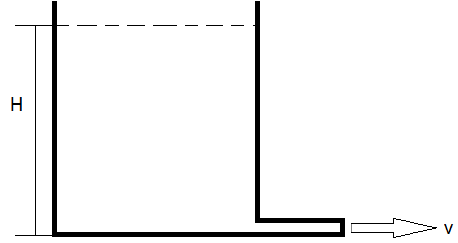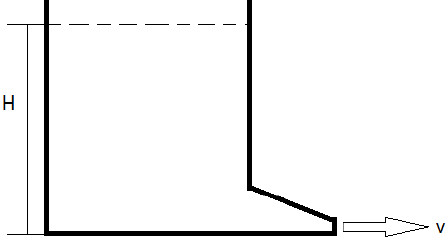This set of Fluid Mechanics Multiple Choice Questions & Answers (MCQs) focuses on “Types of Fluid Flow”.
1. Which method is used exclusively in fluid mechanics?
a) Lagrangian method
b) Eulerian method
c) Both Lagrangian and Eulerian methods
d) Neither Lagrangian nor Eulerian method
View Answer
Explanation: In Fluid Mechanics, the matter of concern is the general state of motion at various points in the fluid system (as in Eulerian approach) rather than the motion of each particle (as in Lagrangian approach). Hence, the Eulerian method is extensively used in Fluid Mechanics.
2. A beaker contains water up to a certain height as shown. If the water is allowed to get discharged through a small pipe (of a uniform diameter), what type of flow will it be in the pipe?

a) steady and uniform
b) unsteady and uniform
c) steady and non-uniform
d) unsteady and non-uniform
View Answer
Explanation: The velocity in which the water is discharged with a velocity
 With time as the water gets discharged,v decreases as H decreases. Hence, it will be an unsteady flow.
With time as the water gets discharged,v decreases as H decreases. Hence, it will be an unsteady flow.According to the continuity equation, ρAV =constant, where ρ= density, A= cross-sectional area of flow, V = velocity of flow. Since water is treated as an incompressible liquid (ρ =constant) and the pipe has a uniform diameter (A =constant) at a given instant, V will remain constant throughout the whole cross-section of the pipe. Hence, it will be a uniform flow.
3. A beaker contains water up to a certain height as shown. If the water is allowed to get discharged through a small nozzle, what type of flow will it be in the pipe?

a) steady and uniform
b) unsteady and uniform
c) steady and non-uniform
d) unsteady and non-uniform
View Answer
Explanation: The velocity in which the water is discharged with a velocity
 With time as the water gets discharged,v decreases as H decreases. Hence, it will be an unsteady flow.
With time as the water gets discharged,v decreases as H decreases. Hence, it will be an unsteady flow.According to the continuity equation, ρAV =constant, where ρ= density, A= cross-sectional area of flow, V = velocity of flow. In this case, water is treated as an incompressible liquid (ρ = constant) but the nozzle has a gradually decreasing diameter (A decreases). At a given instant, V at the exit of the nozzle will be more than that at it’s entrance. Hence, it will be a non-uniform flow.
4. A beaker contains water up to a certain height as shown. If the water is allowed to get discharged through a small diffuser, what type of flow will it be in the pipe?

a) steady and uniform
b) unsteady and uniform
c) steady and non-uniform
d) unsteady and non-uniform
View Answer
Explanation: The velocity in which the water is discharged with a velocity
 With time as the water gets discharged,v decreases as H decreases. Hence, it will be an unsteady flow.
With time as the water gets discharged,v decreases as H decreases. Hence, it will be an unsteady flow.According to the continuity equation, ρAV =constant, where ρ= density, A= cross-sectional area of flow, V = velocity of flow. In this case, water is treated as an incompressible liquid (ρ =constant) but the nozzle has a gradually increasing diameter (A increases). At a given instant, V at the exit of the nozzle will be less than that at it’s entrance. Hence, it will be a non-uniform flow.
5. What type of flow can be taken for granted in a pipe of a uniform cross-section?
a) steady
b) unsteady
c) uniform
d) non-uniform
View Answer
Explanation: According to the continuity equation, ρAV =constant, where ρ= density, A= cross-sectional area of flow, V = velocity of flow. For a pipe of a uniform cross-section, no matter what the rate of flow is, the velocity of flow inside the pipe will always remain constant. Hence, it’ll always be a uniform flow. It’ll be a steady flow if and only if the water level is maintained at a constant level by supplying water at the same rate as it gets discharged, else the water level will keep decreasing with time leading to an unsteady flow.
6. Can the flow inside a nozzle be steady and uniform?
a) yes
b) never
c) it can be steady but never uniform
d) it can be uniform but never steady
View Answer
Explanation: According to the continuity equation, ρAV =constant, where ρ= density, A= cross-sectional area of flow, V = velocity of flow. For a nozzle, the area gradually decreases towards it’s exit. Thus, no matter what the rate of flow is, the velocity of flow at the nozzle exit will always be greater than that at it’s entrance. Hence, it’ll always be an unsteady flow. It can be a steady flow if and only if the water level is maintained at a constant level by supplying water at the same rate as it gets discharged, else the water level will keep decreasing with time leading to an unsteady flow.
7. Which of the following statements is true regarding one and two-dimensional flows?
a) Flow in a pipe is always taken as one-dimensional flow
b) Flow in a pipe is always taken as two-dimensional flow
c) Flow in a pipe is taken as one-dimensional flow when average flow parameters are considered
d) Flow in a pipe is taken as two-dimensional flow when average flow parameters are considered
View Answer
Explanation: The flow inside a pipe can be described by the cylindrical co-ordinate system (r; θ; z), where r is in the radial direction, θ in the angular direction and z in the axial direction. For a circular cross-sections, the flow can be taken to be independent of θ. Hence, it can be taken aa a two-dimensional flow. Again if aerage flow parameters are considered to account for the variation in the radial direction, the flow can be taken as an one-dimensional flow.
8. Which of the following is true?
a) Flow is rotational inside the boundary layer and irrotational outside
b) Flow is irrotational inside the boundary layer and rotational outside
c) Flow is rotational both inside and outside of the boundary layer
d) Flow is irrotational both inside and outside of the boundary layer
View Answer
Explanation: When a torque is applied to a fluid particle, it undergoes a rotation. Thus, the rotation of a fluid particle will alwayds be associated with shear stress. Shear stress is in turn dependent on the viscosity. Hence, rotational flow occurs where the viscosity effects are predominant. Since, viscosity effects are predominant inside the blundary layer, the flow will be rotational in this region. However, outside the boundary layer, the viscosity effects are negligible. Hence, flow can be treated as irrotational outside the boundary layer.
9. Which of the following is true?
a) Flow is laminar inside the boundary layer and turbulent outside
b) Flow is turbulent inside the boundary layer and laminar outside
c) Flow is laminar both inside and outside of the boundary layer
d) Flow is turbulent both inside and outside of the boundary layer
View Answer
Explanation: Flows can be characterized as laminar or turbulent on the basis of Reynold’s number Re = ρvd / μ, where ρ is the density, d is the pipe diameter and μ is the viscosity. For Re < 2000, the flow will be laminar and Re > 4000, the ow will be turbulent. For laminar flow, the viscosity effects must be high (μ should be high) as inside the boundary layer. Outside the boundary layer, the viscosity effects are negligible. Hence, the flow will be turbulent.
10. “The velocity of entrance and exit through a nozzle remains the same.” Is this ever possible?
a) only if the flow is compressible
b) only if the flow is laminar
c) only if the flow is rotational
d) never possible
View Answer
Explanation: According to the continuity equation, ρAV =constant, where ρ= density, A= cross sectional area of flow, V = velocity of flow. If v =constant, ρA =constant. Thus a change is A will mean a change in ρ. Hence, the flow is possible only if the fluid is compressible.
11. Three flows named as 1,2 and 3 are observed. The Reynold’s number for the three are 100, 1000 and 10000. Which of the flows will be laminar?
a) only 1
b) only 1 and 2
c) 1, 2 and 3
d) only 3
View Answer
Explanation: Flows can be characterized as laminar or turbulent on the basis of Reynold’s number Re = ρvd / μ, where ρ is the density, d is the pipe diameter and μ is the viscosity. For Re < 2000, the flow will be laminar and Re > 4000, the flow will be turbulent. Thus, flow 1 and 2 will be laminar.
12. Three flows named as 1,2 and 3 are observed. The flow velocities are v1 and v2. If all other geometrical factors remain the same along with the fluid considered, flow is more likely to be laminar?
a) flow 1 if v1 > v2
b) flow 2 if v1 > v2
c) always flow 1
d) always flow 2
View Answer
Explanation: Flows can be characterized as laminar or turbulent on the basis of Reynold’s number Re = ρvd / μ, where ρ is the density, d is the pipe diameter and μ is the viscosity. If all other geometrical factors remain the same along with the fluid considered, v1 > v2 implies Re1 > Re2. Thus, flow 2 is more likely to be laminar.
Sanfoundry Global Education & Learning Series – Fluid Mechanics.
To practice all areas of Fluid Mechanics, here is complete set of 1000+ Multiple Choice Questions and Answers.
If you find a mistake in question / option / answer, kindly take a screenshot and email to [email protected]
- Check Fluid Mechanics Books
- Apply for Mechanical Engineering Internship
- Practice Aerospace Engineering MCQs
- Practice Mechanical Engineering MCQs
- Check Aerospace Engineering Books
